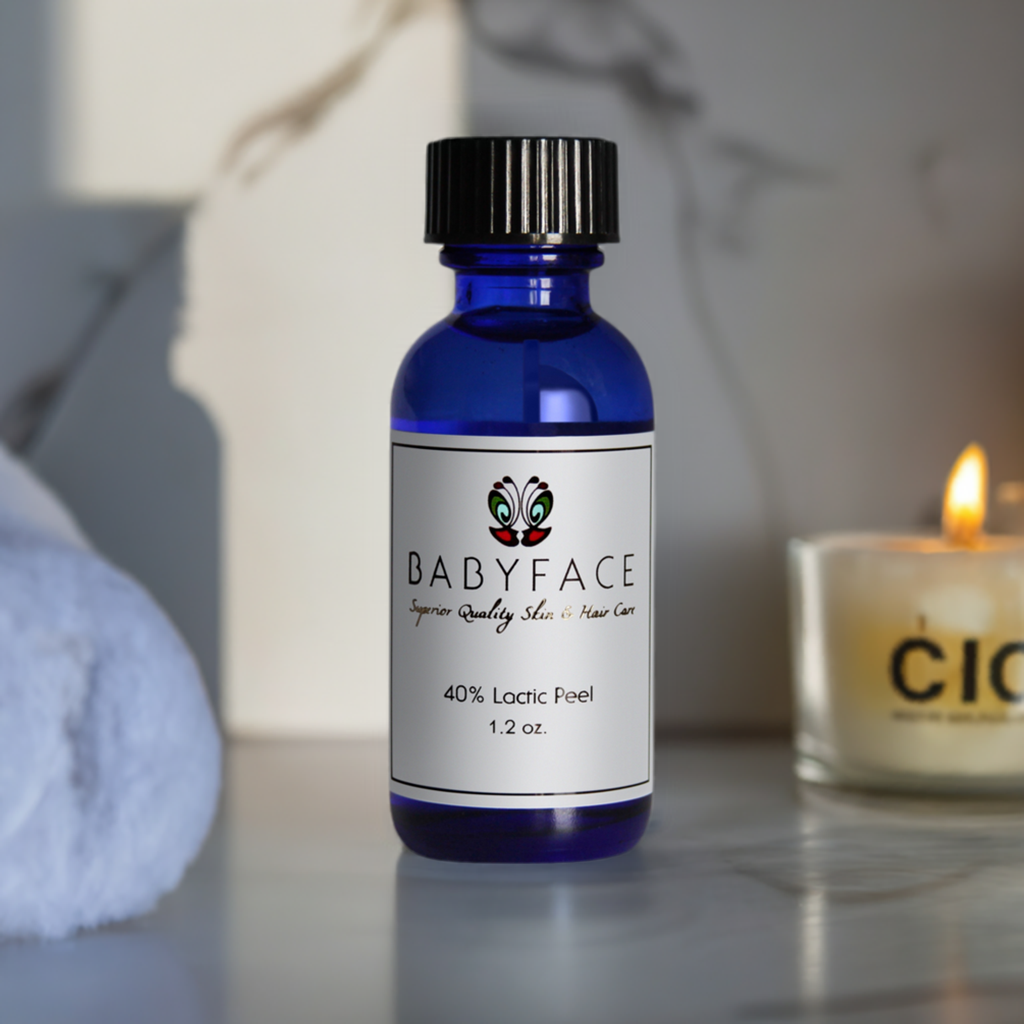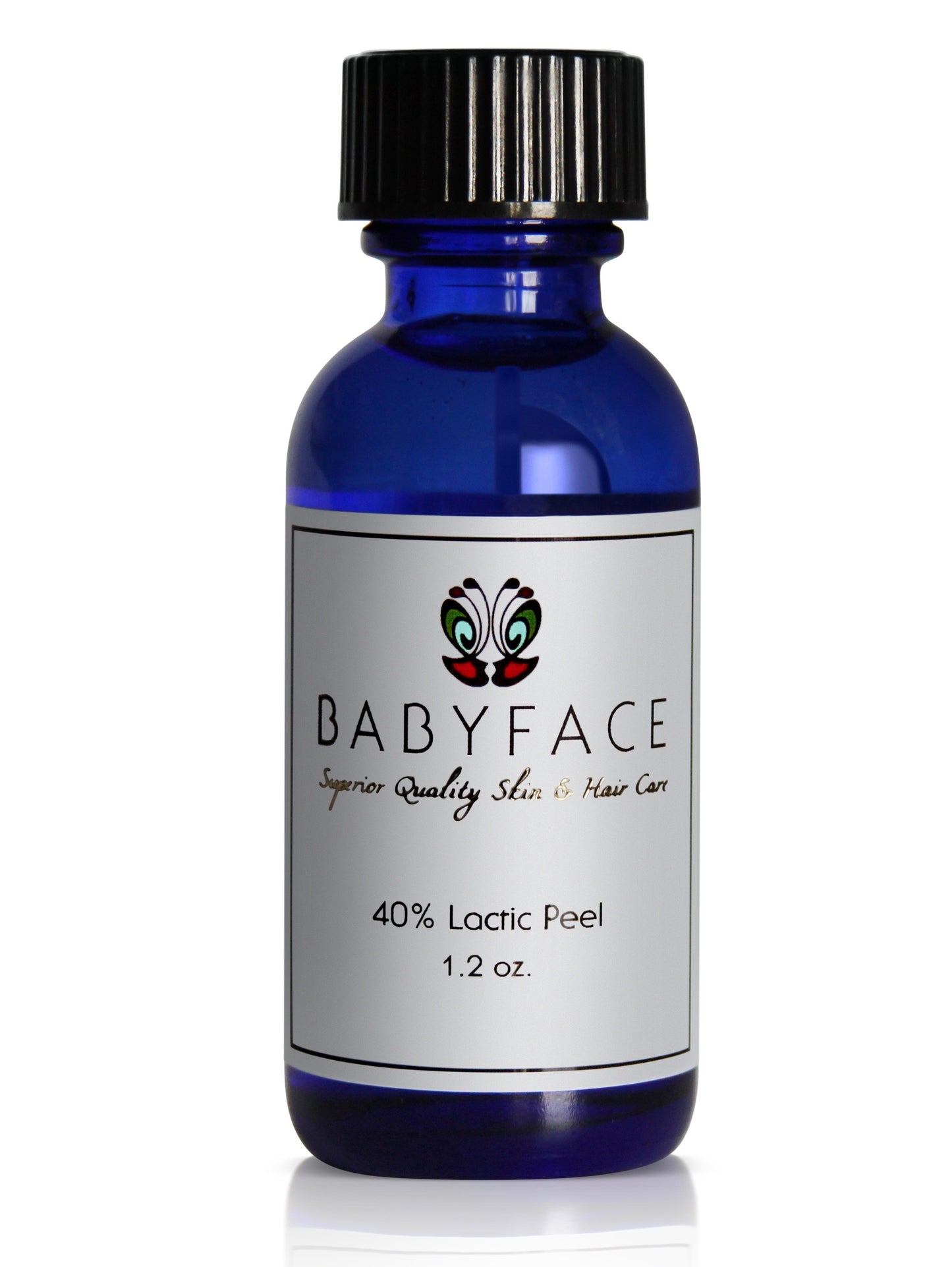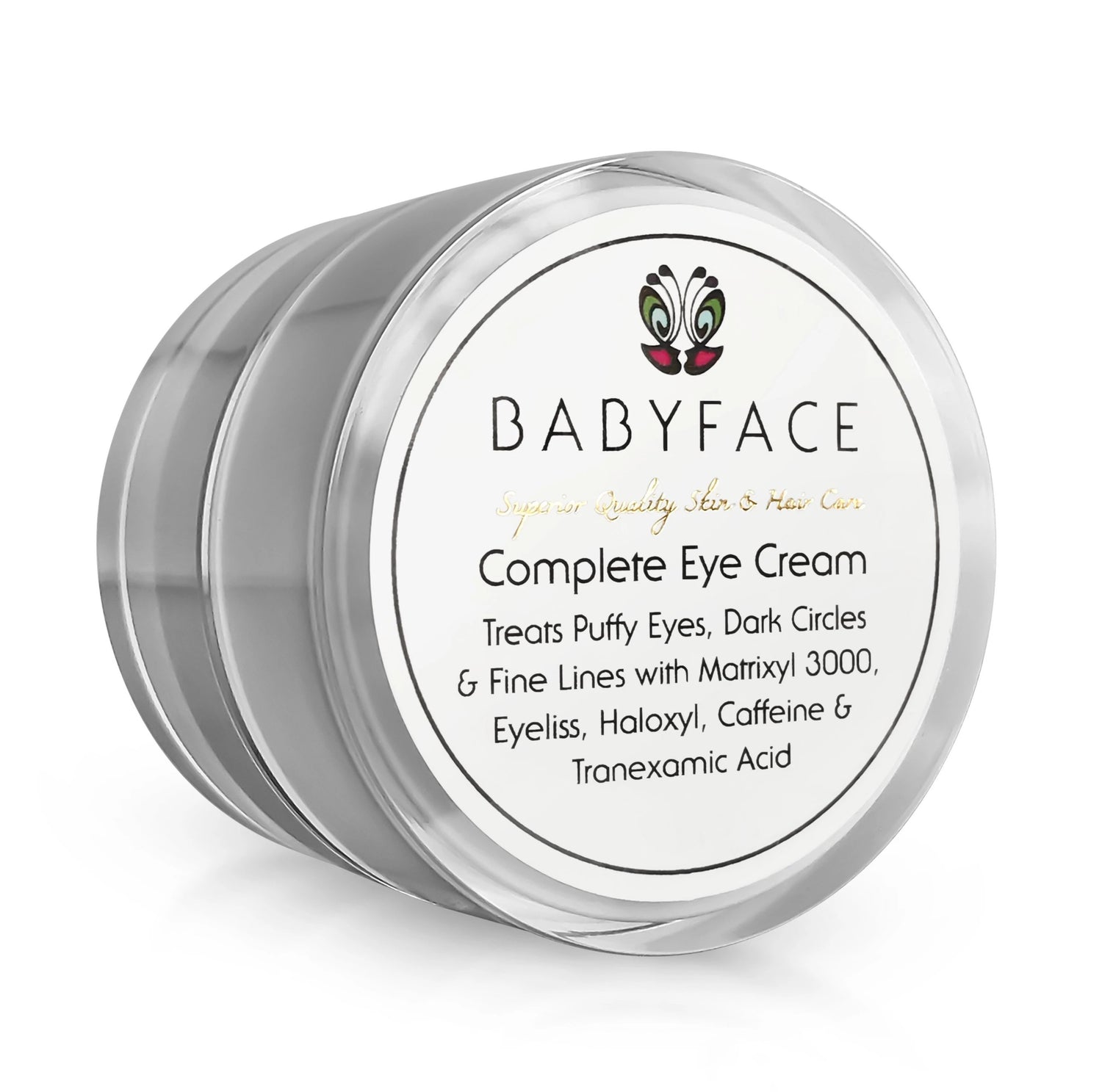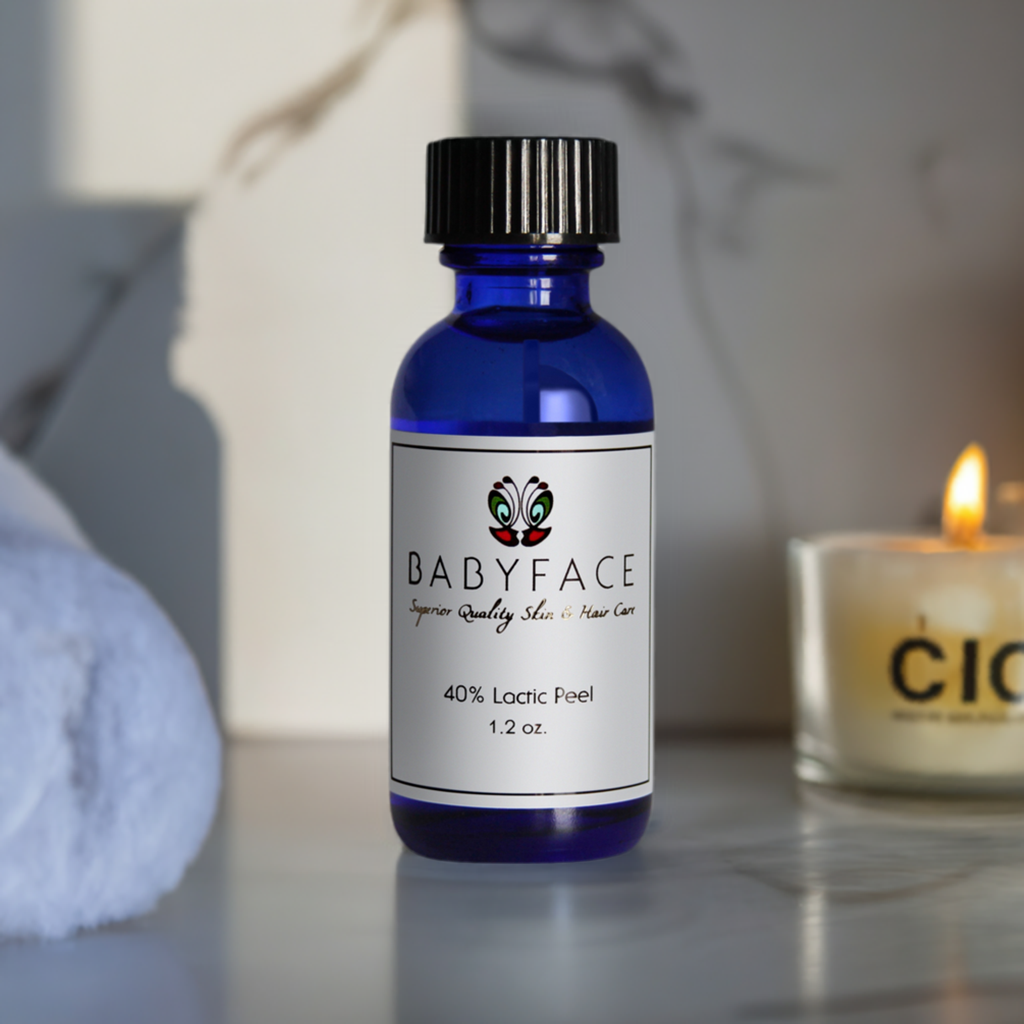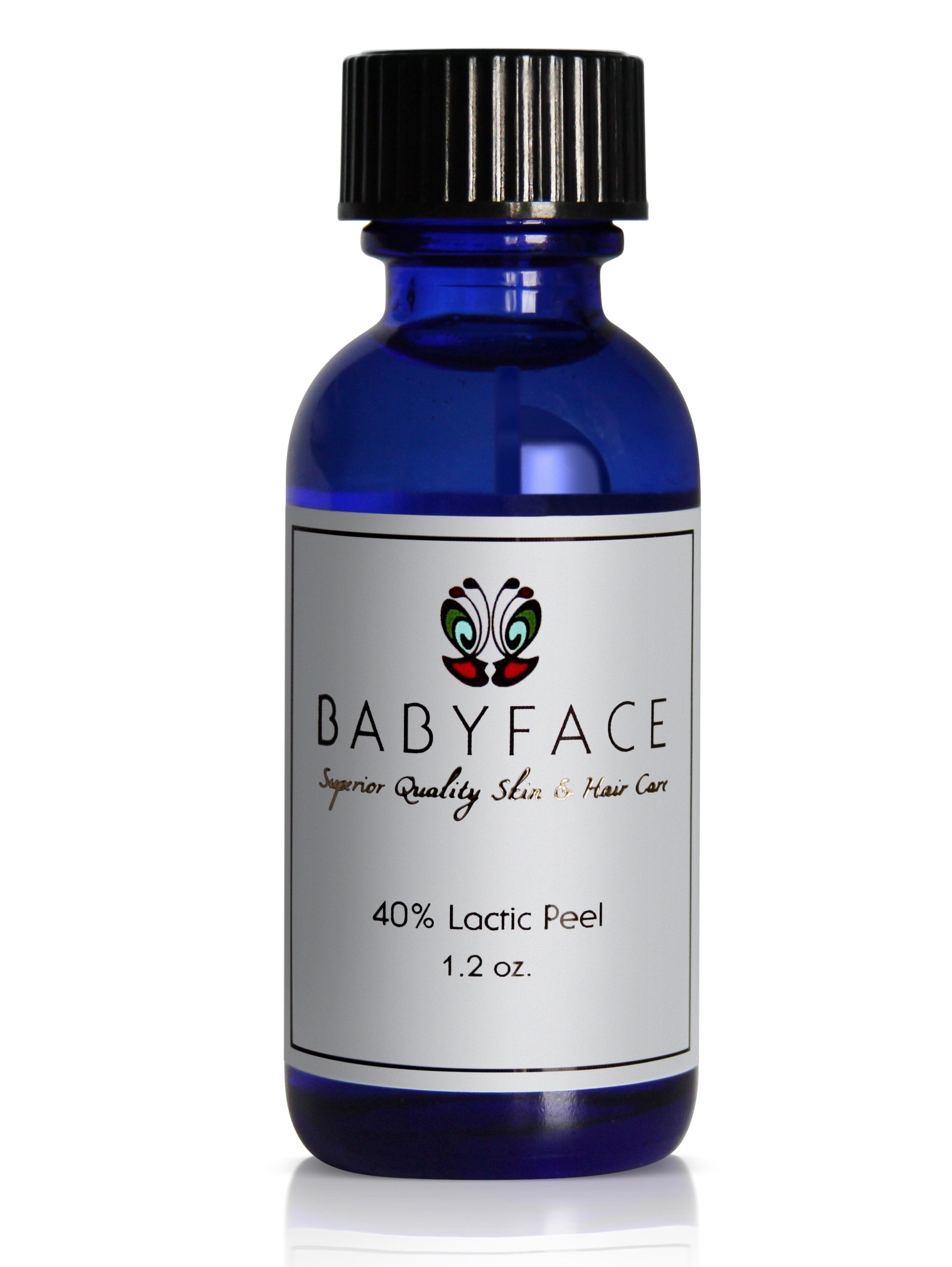Babyface
40% Lactic Acid Chemical Peel, Anti-Aging & Sensitive Skin, 1.2 oz.
40% Lactic Acid Chemical Peel, Anti-Aging & Sensitive Skin, 1.2 oz.
Couldn't load pickup availability
Product Details
Product Details
New to chemical peels? Check out this article to help you choose the best peel for your skin type.
Skin Type: Normal, Dry, Oily, Sensitive, Mature
Benefits of Lactic peels
Lactic acid peels have many benefits for the skin. They exfoliate the surface of the skin, while deep cleaning the pores. They stimulate natural collagen production with skin regeneration, they even out the skin tone and improve hyper-pigmentation of the skin, and will fade dark spots with regular use. They can brighten and lighten the skin, and improve the appearance of wrinkles and fine lines.
Lactic hydrates from within, plumping up dry, parched skin and giving it a more youthful appearance. Especially r ecommended for dry skin and mature skin types.
Lactic acid peels can also help to improve acne and dry up oily skin. A lactic acid peel will remove dead skin cells, toxins, and debris that are on the skin. They will help the skin to maintain the ideal PH level.
Who are they recommended for?
Milder and less irritating than glycolic acid, lactic is excellent for sensitive skin, dry skin, aging skin, oily skin and those suffering from hyperpigmentation. While anyone can (and should!) use lactic, they are especially ideal for those who are new to chemical peels, or cannot tolerate stronger peels. And due to the hydrating properties, dry and mature skin will greatly benefit from them as well.
For those those that have used other exfoliators for a long period can use Lactic in-between as a booster to improve results.
Lactic acid is well known for its hydrating benefits, and will give your skin the smoothing its needs, without the dryness, dehydration, or sensitivity that can occur with other peel procedures.
Additional information on Lactic Acid
Lactic acid peels are a type of chemical peel that is made from AHA (alpha hydroxy acids). They are very mild as they are derived from milk, with a very small chance of an allergic reaction happening. If one has sensitive skin or has never done a chemical peel before, a lactic acid peel is a wonderful choice.
The removal of skin cells can help encourage the skin’s production of natural elastin and collagen. This in turn may help reduce the appearance of wrinkles and fine lines. Lactic Acid is a non-irritating, rapid exfoliating acid. Lactic works fast to slough-off dead skin cells and Lactic can be more suited to those who prefer a gentler peel or for more sensitive skin types.
One of the main ingredients of a lactic acid peel is extracted from sour milk, and unlike other chemical peels, it can help skin with unbalanced pH factors that cause blocked pores and acne.
Recovery Time
Due to the mild nature of Lactic Acid peels, recovery time is virtually nonexistent. Slight irritation or redness may occur to the skin, but it will not be enough to disrupt normal daily activities, and can usually be covered up with make-up starting the day after the peel has been performed.
Expense
Lactic peels can cost anywhere between $150 to $300 per treatment at the Dermatologist or MedSpa, with repeated procedures recommended every 2 to 6 weeks.
Usage
Usage
Skin Patch Test
Always do a skin patch test on the inside of the elbow or behind the ear before applying the 40% Lactic Acid Peel Solution to any larger area. Behind the ear or on the inside of the elbow are recommended spots to do your patch test. A patch test should be done 2 days before you plan to do your peel. The patch test will indicate the level of skin irritation you can expect when you put your peel.
Precautions
- Keep the Lactic Peel at least a quarter of an inch away from the eyes and mucus membranes (nose / inside of mouth).
- If severe skin irritation occurs remove the product by rinsing with cool water immediately and consult a physician.
- Do not apply to irritated, very sensitive skin or skin with open wounds or after extraction.
- Do not apply the Peel Product more than once in a 7 day Period.
- Do not expose treatment area to the sun for 24 hours before or after the application of a chemical peel, and always protect skin from hyper-pigmentation and burns by religiously wearing sunblock when going outside after a peel.
- Do not apply the Peel to skin that has been waxed or shaved within 24 Hours.
- During a chemical peel, experiencing a stinging or itching sensation is normal and this will stop once rinsed off. You can fan the area during treatment if needed for comfort.
- If the product is applied to an area where abrasions or small cuts on the skin produce too much discomfort, neutralize the peel by rinsing with lukewarm water.
- Slight reddening of the skin may occur for a limited period of time, especially with sensitive skin types. Redness usually subsides after a few hours but can last for several days in some cases.
Application of the Product
You may use the lactic peel on your hands, face, neck, or anywhere you have a problem with hyper-pigmentation, sun spots or age spots, acne (but do not apply to any open wounds), wrinkles or scar tissue. Keep away from: eyes, opening to the nose, lips, inside of mouth, hairline and eyebrows. Pay attention to creases, such as on the side of the nose or in deep wrinkles, so that those areas do not get too saturated with solution. Plain water will neutralize the peel when you are finished, but you can also make a neutralizer out of 1/8 teaspoon common baking soda, and 1 cup of cool water.
Step 1: Thoroughly cleanse the face, neck, and hands with a clean cloth, cotton ball or sponge. Rinse with clean warm water and gently pat dry. For thicker skin types, using an exfoliating scrub for a few days before your peel will help to boost penetration and better results can be expected.
Step 2: Apply a Toner to remove all traces of the cleanser and let dry, do not rinse.
Step 3: Apply a small amount of Lactic Acid Peel Solution to a cotton ball or you can dip a Q-Tip into the peel solution. Do not re-dip the same Q-Tip after used for application; use a new Q-Tip for each dip. Apply 1 layer of the solution to the area cleansed and toned. For face, start with the forehead first, chin second, and then apply solution to the more sensitive cheeks last. Leave on for recommended amount of time, as long as skin tolerates it. Some people with sensitive skin will require less time.
Recommended Treatment Time Limits
Treatment #1: Product left on for up to 1 minute to assess skin’s tolerance.
After 1-2 weeks, if skin is completely healed, you can do your next treatment.
Maintenance treatments: Product left on for 1-2 minutes (as skin tolerates it). Adjust time or peel strength to suit your individual skin’s needs.
After 2 peels, allow skin rejuvenate for 2-4 weeks before doing further treatments.
Step 4: Rinse product from skin with cool clean water (or use a neutralizer). Gently pat skin dry (do NOT rub skin).
Step 5: If needed, you can apply Babyface’s Pure Emu Oil to soothe skin after treatment. Gentle lotions are OK too – but may sting, so apply to small area to test first.
Note: Peeling is usually not common but can sometimes occur on some skin types. If your skin peels after a treatment it is very important to leave it alone, and do not pick at peeling skin – this can cause scarring. Let skin peel naturally, on it’s own. Babyface’s Pure Emu Oil can help disguise peeling, if needed.
Ingredients
Ingredients
Ingredients: Water, Lactic Acid, HydroxyEthylCellulose/Acrylates Co-polymer, Diazolidinyl Urea (and) Iodopropynyl Butylcarbamate
Share
